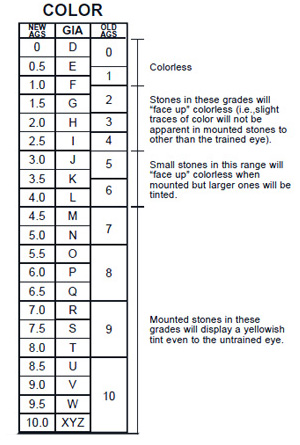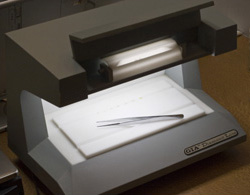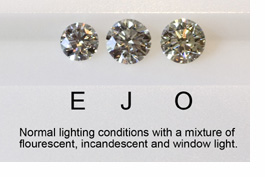Color-Grading Diamonds
What color is a diamond? No one talks much about the color of the diamond in their engagement ring. If it's not a fancy color — say pink or blue — it's colorless and it sparkles. Isn't it really carat weight that matters anyway? What's all the fuss about color grading?
For most of history, diamonds were so rare that grading their color didn't much matter. In 17th century India, diamonds were color-graded at night, by lamplight—not ideal conditions for distinguishing subtleties.
As diamonds became more accessible, their color grew to be an important consideration in valuation. But describing lack of color is a problem. In the late 19th century, graders used metaphorical terms, like "river" or "water," for the purest, most colorless diamond.
Or the color was named after a geographical location where similarly colored diamonds were found. "Cape," used for diamonds from the Cape of Good Hope region, is still in use today to refer disparagingly to pale yellow diamond. Such designations are general, at best. What the diamond industry needed was . . .
 A "color yardstick"
A "color yardstick"
Today, diamond grading has come a long way from flickering lamps and poetic designations. If you've ever glanced at a GIA diamond report, or at the back of a JISO Jewelry Appraisal form, you've seen the D-to-Z color grading chart established by the GIA (Gemological Institute of America). The illustration includes the AGS scale, also in wide use, but the GIA scale is considered the international standard.
The quest for a "color yardstick," as it was described in the 1940s, began in earnest in the mid-20th century and has been perfected over the years. Letter grades eliminate the use of ambiguous and idiosyncratic terms.
The GIA system ranges from colorless (D) to increasingly yellow, or "off color," diamonds. The GIA scale began with D to avoid confusion with earlier, less stringent, grading systems that used grades like "A" and "AA."
Accurate use of the D-Z system depends on a set of master stones precisely graded by GIA. The gemologist compares the diamond in question to stones in the master set, and arrives at a grade.

Master stones, with their corresponding GIA color grade
It sounds easy enough—but then, there's the light. That flickering oil lamp is not like daylight. Light in the morning is not the same as at high noon. Summer's light is not like winter's. Incandescent light is not like fluorescent. Ambient colors also matter—reflections from the walls, or other objects on the table, or the grader's clothes.
Since the presence of even the slightest tinge of color is what's at issue, the influence of ambient colors must be minimized. If the system is to be a standard, the light and viewing conditions must be the same for all graders.
 |
GIA's Diamond Light viewing box |
To address the situation, technicians began working on a viewing box that would provide a standardized viewing environment. Over the years, they experimented with various kinds of lighting to simulate ideal daylight, adjusted the size and shape of the box, and developed various inside coatings to reduce glare and reflection. Today's viewing boxes create optimal conditions for comparing a stone to the master set of graded stones.
Why does it matter?
As usual, the answer is money. This chart compares the values of two 1-carat diamonds, alike in clarity (IF, or internally flawless) and cut (very good), but one color grade apart.
Color Grade |
Clarity Grade |
Supplier Cost |
Retail* Price |
D |
IF |
$18,000 |
$27,000 |
E |
IF |
$12,600 |
$18,900 |
*This example assumes a typical markup of 50%.
We often see appraisals at three times (or more) the cost of the diamond.
We consider such valuations inflated, and you should, too.
As we see, a difference of just one color grade means a huge difference in price.
 To accurately grade a diamond's color, the jeweler/appraiser must have not only the proper training and a good eye, he must also have the necessary equipment in his gem lab to do a proper analysis.
To accurately grade a diamond's color, the jeweler/appraiser must have not only the proper training and a good eye, he must also have the necessary equipment in his gem lab to do a proper analysis.
The potential for fraud is great. It is very easy to exaggerate a color grade, since a one-grade difference is not visible to the naked eye. As you can see from this comparison, even greatly magnified diamonds that are several grades apart can look similar, though their difference in value could be thousands or even tens of thousands of dollars.
So the appraiser must also be trustworthy, both in terms of training and honesty. A mistake of even one color grade — or a deliberate inflation of the grade — can be very costly to the buyer and, in case of loss, to the insurer.
Color—and the other 4 Cs
Color is only one of the 4 Cs that affect the value of a diamond. The others—Clarity, Carat weight, and especially Cut—also figure in.
The accuracy of each grade on the appraisal
—each of the 4 Cs—
dramatically affects valuation.
FOR AGENTS & UNDERWRITERS
Be sure the appraisal completely describes the jewelry, including the 4 Cs of diamond. If information is "left out" of the appraisal, either through carelessness or deceit, you can be sure the error is not in favor of the buyer/insurer.
JISO jewelry appraisals prompt the appraiser for all information. These appraisals guarantee that the jewelry has been examined in a gem lab and graded by the appraiser signing the form.
Especially for high-value jewelry, recommend that your clients secure a JISO 78/79 appraisal.
Certified Insurance Appraisers™ (CIAs) are graduate gemologists who have had additional training in appraising for insurance. CIAs are qualified to write JISO 78/79 appraisals.
If a CIA is not available, ask your client to have the selling jeweler complete JISO 805 or to have any jeweler/appraiser use JISO 806.
For high-value diamond jewelry, you should get a diamond report in addition to an appraisal. Be sure the report is from a reliable lab.
To check the authenticity of a diamond report from these reliable labs, follow the appropriate link:
GIA Report Check
AGS Report Verification
GCAL Certificate Search
Gübelin Gem Lab
FOR ADJUSTERS
When pricing a replacement, give the replacing jeweler all descriptive information from the appraisal and other documents. Do not give the valuation. The replacement price should be based on the quality of the jewelry (as described on the appraisal and lab report), not on your limit of liability or on the original purchase price.
Trust only diamond reports from reliable labs. Use the links above to check the authenticity of a report.
If the report is not from one of the respected labs listed above, compare the report's description with the description on the appraisal. Compare the valuation with the purchase price, if available. When a large settlement is at issue, it could be worthwhile to consult a jewelry insurance professional to help determine the true quality and value of the jewelry and avoid a large overpayment
©2009, JCRS Inland Marine Solutions, Inc. All Rights Reserved. www.jcrs.com
©2000-2025, JCRS Inland Marine Solutions, Inc. All Rights Reserved. www.jcrs.com

